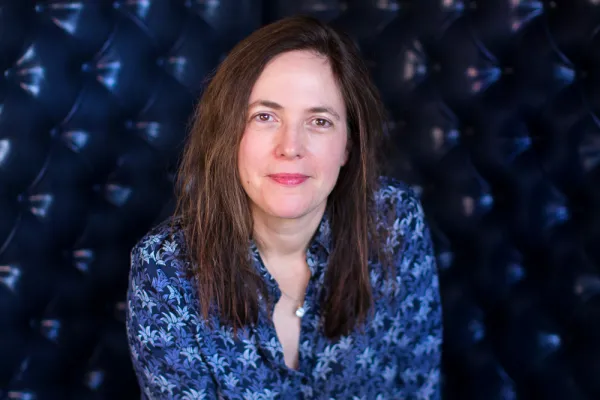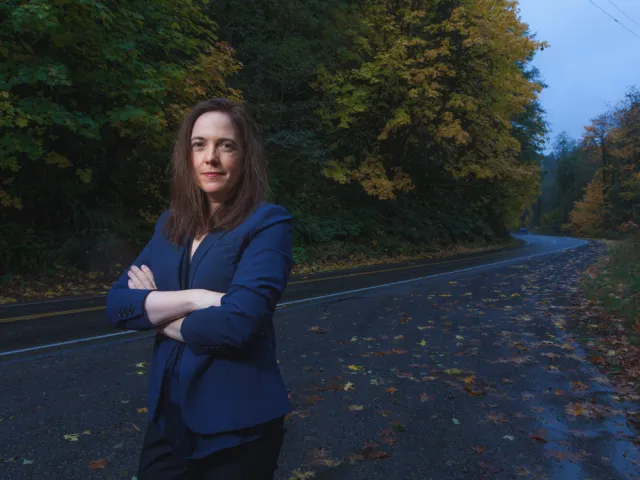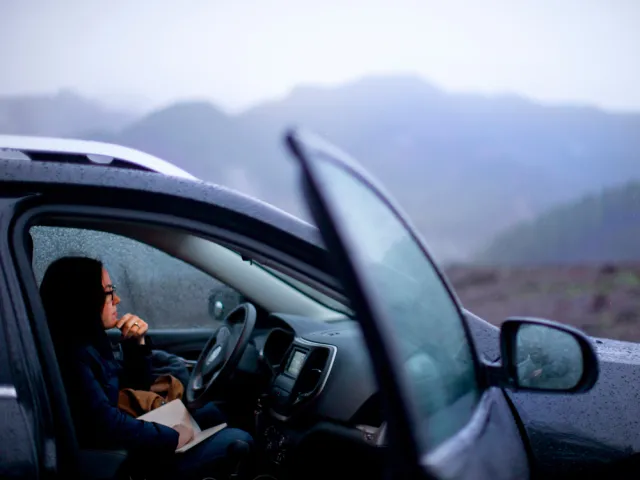The Haunting Stories of Highway 20
Alum News

Published December 5, 2019
In late 2016, I began investigating a little-known killer named John Arthur Ackroyd, who, decades earlier, had stalked a stretch of U.S. 20 through Oregon. My editor wanted to know if a handful of cold cases involving young women whose bodies or clothing had been found in the surrounding woods were linked to Ackroyd, a former state highway mechanic who traveled the route for work and who was already serving time for one murder in that area. While poring over thousands of pages of court records in a rural courthouse, I came across a decades-old police report about the rape of a young Native American mother, a woman who survived the attack but whose story police were all too willing to disbelieve.
I had a feeling she might be connected, so I made a copy of the police report; the writing on some of the pages was so old it was hard to read. Then I drove three hours back home through Oregon’s high desert and Cascade Mountains to Portland, where I’m a senior reporter for The Oregonian, the state’s largest news organization.
The report named the alleged victim as Marlene Gabrielsen. I opened a newsroom database and found her name immediately. She lived in suburban Portland and was about the right age to be the same person who had survived the violent encounter with a stranger off Highway 20 in 1977. I typed out a letter and dropped it into the mail. Would she reply?
A few weeks later, Gabrielsen’s name appeared in my email inbox. It was a defining moment in what would become a two-year reporting project. Those police reports I’d dug up made clear that in 1977 the cops thought Marlene had lied. It was also clear that they ignored damning physical evidence that implicated her attacker: the boots that he’d sliced with a knife, jeans he’d ripped from crotch to hemline and the reports of traumatic injuries, documented just hours after the attack by an emergency room doctor.
In 1977, the accused rapist—identified as John Ackroyd—had denied it, insisting to the small-town detective that 20-year-old Marlene had seduced him in the cab of his beat-up truck. Both underwent lie-detector tests. Police interrogated Marlene, picking apart minor details in her chilling account, given within hours of the attack.
Now, four decades later, it was clear to me that their decision to disregard Marlene not only deepened her trauma but also set her attacker on a lethal trajectory. It wasn’t the first time I’d seen a woman’s account of rape go ignored. I’ve reported extensively on sexual assault survivors’ experiences with law enforcement and their frustration with the criminal justice system. I’ve chronicled the devastating consequences of silencing women: the profound betrayal women feel when they are disbelieved and the erosion of public trust in police and other institutions designed to keep communities safe. In Marlene’s story, I saw a familiar and tragic phenomenon: She was another woman who didn’t seem to matter.
Marlene had not talked much about the assault over the years, but her silence did little to quiet her rage. Yes, she wrote back, she would meet with me. But before she would answer any of my questions, Marlene had one of her own:
Why did I care?
I'm the daughter of a social worker mother whose humanity and compassion were rivaled only by her work ethic. My father was a newspaperman who gravitated toward stories about Rhode Island’s marginalized communities, often immigrants and others unaccustomed to seeing their lives reflected in the pages of a big-city newspaper. In the 1980s, after the conviction of four men in an infamous and highly publicized rape trial, my father spoke out. The case divided the community and became a flashpoint for victims of domestic and sexual violence. After the verdict, defenders of the men descended on the local courthouse in protest. My mild-mannered father told those who had gathered that women are too often ignored and mistreated, remarks that were criticized by some as a breach of journalism’s tenet of impartiality. But that day my father upheld another principle fundamental to the job: He told the truth. I was a kid then, but my father’s decision to use his voice to lift those who had been silenced left a lasting impression. After graduating from Smith, I followed my father into journalism. It is the only job I’ve ever known.

Photograph by Robbie McClaran
It’s no surprise that in my own work, I look for injustice and stories about people whose experiences would otherwise go unnoticed. I’ve spent most of my 26-year career reporting on crime and justice, exposing and explaining the dark side of human nature and its consequences. I’ve done deep dives into white supremacists, bad cops and notorious killers. That’s how I got the assignment to investigate John Ackroyd’s possible ties to unsolved murders in the Oregon woods.
When I started reporting this series, Ackroyd was serving a life sentence in the state penitentiary for the 1978 killing of Kaye Turner, a 35-year-old woman who had vanished one winter morning while on a run in a rustic central Oregon resort. It had taken 14 years to bring Ackroyd to justice for Kaye’s killing, and in those intervening years other young women he knew or crossed paths with had gone missing or turned up dead.
His victims were like Marlene: young and vulnerable. They included his 13-year-old stepdaughter, Rachanda Pickle, and two restless teens, Melissa Sanders and Sheila Swanson, who vanished not long after meeting him. They lived near Highway 20, a U.S. highway that winds through old logging towns and some of Oregon’s most spectacular scenery before ending at the Pacific Ocean. Those cases—and four others involving one man and four women who disappeared under similar circumstances—had never been solved. In life, his victims had been invisible. After their deaths, they’d been largely forgotten.
I spent months piecing together Ackroyd’s past and in the process unearthed crucial information linking him to these crimes. I interviewed dozens of people, amassed thousands of pages of police and court records, listened to hours of recordings of police interrogations and traveled out of state to track down key witnesses, including some who had never spoken publicly about what they had seen and heard. The Oregonian went to court to unseal records that held answers to key questions. I sought to expose not only a rapist and killer who had hidden in plain sight but also to shine a light on the victims and the lives they led. In the course of revealing a profound injustice, I wanted to tell the truth about these women, to render the ghosts visible.
As my reporting took shape, my editor and two partners on the project, both visual journalists, spent hours talking about how to tell a sprawling story that spanned decades and covered a large swath of Oregon wilderness.
We knew we had to do more than highlight yet another serial killer. We didn’t want to be the latest true-crime series to spotlight investigators and treat tragedy as entertainment and victims as afterthoughts. Ours was a story of police malpractice and justice denied, of a man who counted on society’s blind eye to marginalized people to escape prosecution for decades.
What would happen, we wondered, if we framed the series around the women he killed and the people who loved them?
What if instead of focusing on his story we told theirs?
I met Marlene one fall day in 2016 in the meeting room of a church around the corner from her house. That day, she told me what happened, the trauma having seared the details into her memory. She had been hitchhiking when Ackroyd picked her up and drove her deep into the woods off Highway 20 and raped her. Afterward, she sensed he didn’t know what to do with her—he even said so. She used her wits to stay alive. And lived so she could report him to the cops.
They would help, she thought. But they didn’t. “I figured it was because I was nothing, I wasn’t going to amount to anything,” she told me. “I was brown and I was ugly.”
Ackroyd was never brought to justice for Marlene’s rape. He went on to rape and kill Kaye Turner, a stranger he stalked while she was on a run. Later, his stepdaughter, Rachanda Pickle, vanished from the family’s home in a desolate outpost off the highway. Then teenagers Melissa Sanders and Sheila Swanson disappeared while on a camping trip to the Oregon coast. Rachanda’s body was never found; the remains of Melissa and Sheila were later discovered on a logging spur off Ackroyd’s work route.
What happened to Marlene was a shock to the conscience, and yet it lay buried amid old court records. She reported her assault only to be treated as a liar. In searching for clues to unsolved murders, I’d stumbled upon a story as relevant in the era of the #BelieveHer and #MeToo movements as it was 40 years ago. Women like Marlene, who are victimized by male predators, are often not believed when they report harassment, assault or rape. As a result, they often feel forsaken and unseen. They feel like ghosts.

Oregonian reporter Noelle Crombie ’92 on assignment along Highway 20 in rural Oregon. Photograph by Beth Nakamura for The Oregonian
I suspected that after suffering alone for decades, Marlene might finally find a measure of peace in telling her story.
But Marlene didn’t know any of that when she opened my letter. All she knew was that even after so many years, someone was interested in hearing her story. “That’s what made me come,” she said. “There is someone that actually cares.”
“There is someone that actually cares.”
When it was published in December 2018, Ghosts of Highway 20 was the most ambitious multimedia project in the history of The Oregonian. It included a 7,000-word narrative and a five-part documentary video series. The documentary series featured an original score, as well as Lucinda Williams’ haunting song “The Ghosts of Highway 20.” (That the song is about a Highway 20 in another part of the country didn’t diminish its effect.)
The series and documentary struck a chord with the public. Reader email flooded my inbox. Many were heartened to see such immersive storytelling in a time of dwindling resources for news organizations and said they would always remember the women whose stories were finally told. “I am moved that by telling this story you were able to give voice to so many people who have largely gone unheard until now,” one reader wrote. For me, the series underscored the reasons I went into journalism: to amplify the experiences of those who go overlooked, to highlight injustice and to uncover the truth.
The week that the project was published, the Northwest Film Center held a free screening for the project’s documentary in downtown Portland. Marlene was there that night, seeing the series for the first time. Afterward, when I introduced Marlene, a remarkable thing happened: The audience of 300 or so people rose to its feet and cheered.
Ackroyd was never convicted of another murder. He died in his prison cell in 2016, so Marlene didn’t get the satisfaction of facing her attacker in court. But it could be that revealing her story to the world delivered something close to justice—even if it was delayed.
Later that evening, Marlene and I said our goodbyes. Before she headed into the winter night, Marlene thanked me. At last, she said, she was free.
This story appears in the Winter 2019-20 issue of the Smith Alumnae Quarterly.
SMITH ID
NOELLE CROMBIE ’92 Senior reporter, The Oregonian, Portland, Oregon
CAREER: Crombie reports extensively on criminal justice issues and this year led a 10-month investigation into sexual abuse allegations against the co-founder of a high-profile humanitarian aid organization. Her team’s 2018 narrative and documentary series, Ghosts of Highway 20, won five Northwest Regional Emmys and the Bruce Baer Award for Oregon’s best investigative reporting. It was a finalist for the Scripps Howard multimedia journalism award and won the integrated storytelling award from the Society for Features Journalism.
SENIOR HOUSE: Morrow
MAJOR: Government
SMITH MEMORY: Afternoon tea and candlelight dinner traditions; spending time with friends; Art 100
Photograph by Beth Nakamura for The Oregonian